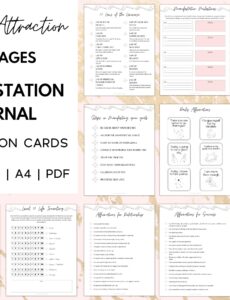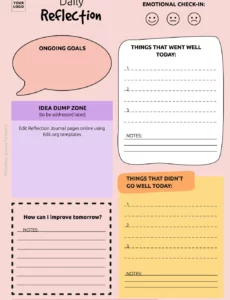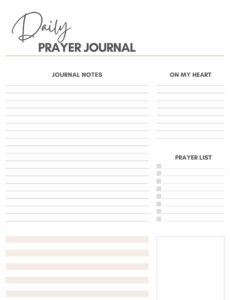Embarking on a journey towards better mental well-being often involves understanding the intricate dance between our thoughts, feelings, and behaviors. It is a powerful path of self-discovery, where you learn to challenge unhelpful patterns and cultivate more adaptive ways of thinking and reacting. One of the most effective tools in this journey, widely recommended by therapists and mental health professionals, is journaling.
Journaling, particularly when structured around the principles of Cognitive Behavioral Therapy (CBT), offers a tangible way to observe and process your inner world. It provides a dedicated space to record events, analyze immediate reactions, and ultimately gain insight into the mechanisms that drive your emotional responses. But how do you make the most of this process? A well-designed cognitive behavioral therapy journal template can be your guiding star.
Why a CBT Journal is Your Mental Wellness Ally
Think of your mind as a bustling city, full of traffic, shortcuts, and sometimes, unexpected detours. A CBT journal acts like a detailed map, helping you navigate these complex routes. It is not just about writing down your feelings; it is about systematically examining the connections between situations, your automatic thoughts, the emotions these thoughts evoke, and the actions you subsequently take. This structured approach is fundamental to CBT, which posits that by changing our thoughts, we can change our feelings and behaviors.
This consistent practice helps you identify what are often called cognitive distortions – those irrational or unhelpful thinking patterns that can lead to negative emotions and self-defeating actions. Maybe you tend to catastrophize, jumping to the worst possible conclusion, or perhaps you engage in all-or-nothing thinking. By seeing these patterns written down, you begin to recognize them in real-time, empowering you to pause and choose a different path.
Understanding the Core Components
A good CBT journal entry usually breaks down an experience into several key components, often referred to as the ABCs (Activating event, Beliefs, Consequences) and sometimes extending to ABCDE (Disputation, Effective new belief). This systematic approach helps you dissect your experiences.

Here are the essential elements you will want to consider including:
- Situation (Activating Event): What happened? Who was involved? Where were you? Be as factual and objective as possible.
- Thoughts (Beliefs): What automatic thoughts went through your mind immediately after or during the situation? These are often quick, unfiltered thoughts.
- Emotions (Consequences): What feelings did you experience? Be specific (e.g., anxious, sad, angry) and rate their intensity (e.g., on a scale of 1-10).
- Physical Sensations: Did you notice any physical reactions in your body? (e.g., tight chest, sweaty palms, stomach ache).
- Behavior: What did you do or not do in response to the situation and your thoughts/emotions?
By breaking down experiences in this manner, even without initially challenging your thoughts, you start to see the chain reaction that unfolds within you. This initial awareness is the first crucial step towards gaining control and fostering change.
Designing Your Perfect Cognitive Behavioral Therapy Journal Template
The beauty of creating your own cognitive behavioral therapy journal template lies in its adaptability. While the core principles remain consistent, you can tailor it to your specific needs, making it a truly personal and effective tool. The goal is to make the journaling process accessible and intuitive, encouraging regular engagement rather than feeling like a chore. Consider what details are most relevant to your struggles or goals, and build your template around those insights.
When you are ready to put pen to paper, or fingers to keyboard, having a clear structure for each entry makes the process much smoother. This structure serves as a gentle reminder of the essential questions to ask yourself, ensuring you cover all the bases needed for effective self-reflection and cognitive restructuring.
Here are some suggested elements to include in your journal template:
- Date and Time: Always start here to track patterns over time.
- Situation/Trigger: A brief, factual description of the event or trigger.
- Automatic Thoughts: List all thoughts that popped into your head, even seemingly minor ones.
- Emotions: Identify and rate the intensity of your feelings (e.g., % out of 100).
- Physical Sensations: Note any bodily reactions.
- Challenging Thoughts/Evidence For and Against: This is where you become your own detective. What evidence supports your automatic thought? What evidence refutes it? Are there alternative explanations?
- New Perspective/Balanced Thought: After challenging, what is a more realistic, balanced, or helpful thought you can adopt?
- Behavior: What action did you take or consider taking? How did this behavior align with your goals?
- Outcome/Learning: How do you feel now? What did you learn from this experience?
Using such a template regularly transforms journaling from a simple diary entry into a powerful therapeutic exercise. It encourages you to not just vent, but to actively engage with your inner narratives, question their validity, and intentionally reshape them into more constructive ones. Consistency is key here; even a few minutes each day or whenever a significant event occurs can yield profound insights.
Embracing the practice of a structured journal can be a truly transformative experience for your mental well-being. It offers a tangible record of your progress, allowing you to look back and see how far you have come in understanding and managing your thoughts and emotions. This tool empowers you to become a more active participant in your mental health journey, fostering resilience and a deeper connection with yourself. Starting this practice today could be the most valuable step you take towards cultivating a more balanced and fulfilling life.





